tire type Acura MDX 2015 Owner's Guide
[x] Cancel search | Manufacturer: ACURA, Model Year: 2015, Model line: MDX, Model: Acura MDX 2015Pages: 79, PDF Size: 16.44 MB
Page 2 of 79
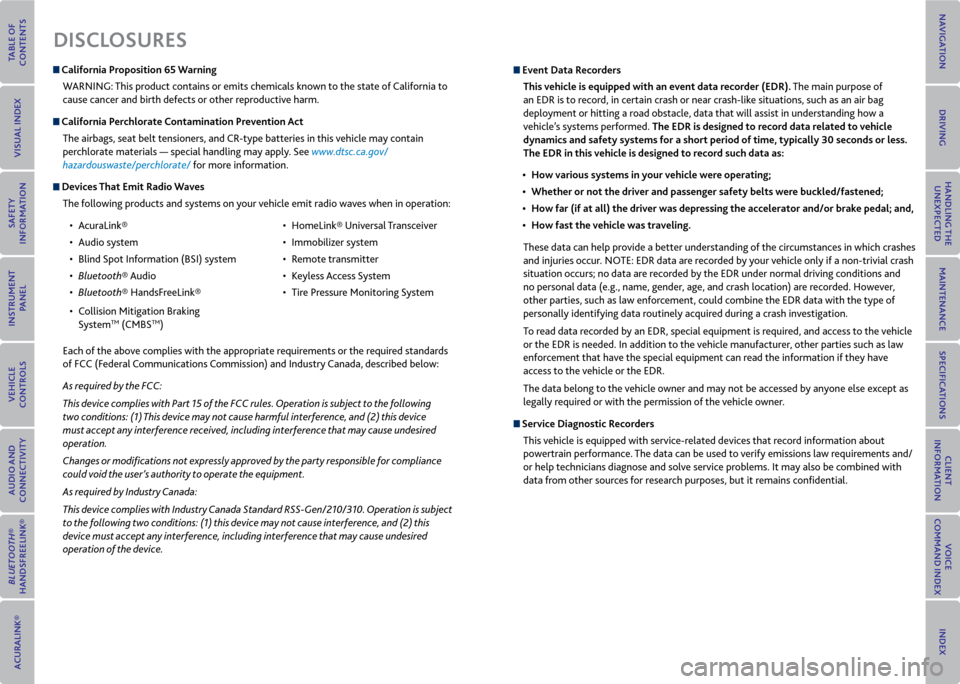
DISCLoSUreS
California Proposition 65 Warning
WARNING: This product contains or emits chemicals known to the state of California to
cause cancer and birth defects or other reproductive harm.
California Perchlorate Contamination Prevention ActThe airbags, seat belt tensioners, and CR-type batteries in this vehicle may contain
perchlorate materials — special handling may apply. See www.dtsc.ca.gov/
hazardouswaste/perchlorate/ for more information.
Devices That emit radio Waves
The following products and systems on your vehicle emit radio waves when in operation:
• AcuraLink®
• Audio system
• Blind Spot Information (BSI) system
• Bluetooth® Audio
• Bluetooth® HandsFreeLink®
• Collision Mitigation Braking
System
TM (CMBSTM) •
HomeLink® Universal Transceiver
• Immobilizer system
• Remote transmitter
• Keyless Access System
• Tire Pressure Monitoring System
Each of the above complies with the appropriate requirements or the required standards
of FCC (Federal Communications Commission) and Industry Canada, described below:
As required by the FCC:
This device complies with Part 15 of the FCC rules. Operation is subject to the following
two conditions: (1) This device may not cause harmful interference, and (2) this device
must accept any interference received, including interference that may cause undesired
operation.
Changes or modifications not expressly approved by the party responsible for compliance
could void the user’s authority to operate the equipment.
As required by Industry Canada:
This device complies with Industry Canada Standard RSS-Gen/210/310. Operation is subject
to the following two conditions: (1) this device may not cause interference, and (2) this
device must accept any interference, including interference that may cause undesired
operation of the device.
event Data r ecorders
This vehicle is equipped with an event data recorder (eDr). The main purpose of
an EDR is to record, in certain crash or near crash-like situations, such as an air bag
deployment or hitting a road obstacle, data that will assist in understanding how a
vehicle’s systems performed. The eDr is designed to record data related to vehicle
dynamics and safety systems for a short period of time, typically 30 seconds or less.
The eDr in this vehicle is designed to record such data as:
• How various systems in your vehicle were operating;
• Whether or not the driver and passenger safety belts were buckled/fastened;
• How far (if at all) the driver was depressing the accelerator and/or brake pedal; and,
• How fast the vehicle was traveling.
These data can help provide a better understanding of the circumstances in which crashes
and injuries occur. NOTE: EDR data are recorded by your vehicle only if a non-trivial crash
situation occurs; no data are recorded by the EDR under normal driving conditions and
no personal data (e.g., name, gender, age, and crash location) are recorded. However,
other parties, such as law enforcement, could combine the EDR data with the type of
personally identifying data routinely acquired during a crash investigation.
To read data recorded by an EDR, special equipment is required, and access to the vehicle
or the EDR is needed. In addition to the vehicle manufacturer, other parties such as law
enforcement that have the special equipment can read the information if they have
access to the vehicle or the EDR.
The data belong to the vehicle owner and may not be accessed by anyone else except as
legally required or with the permission of the vehicle owner.
Service Diagnostic r ecorders
This vehicle is equipped with service-related devices that record information about
powertrain performance. The data can be used to verify emissions law requirements and/
or help technicians diagnose and solve service problems. It may also be combined with
data from other sources for research purposes, but it remains confidential.
Page 39 of 79
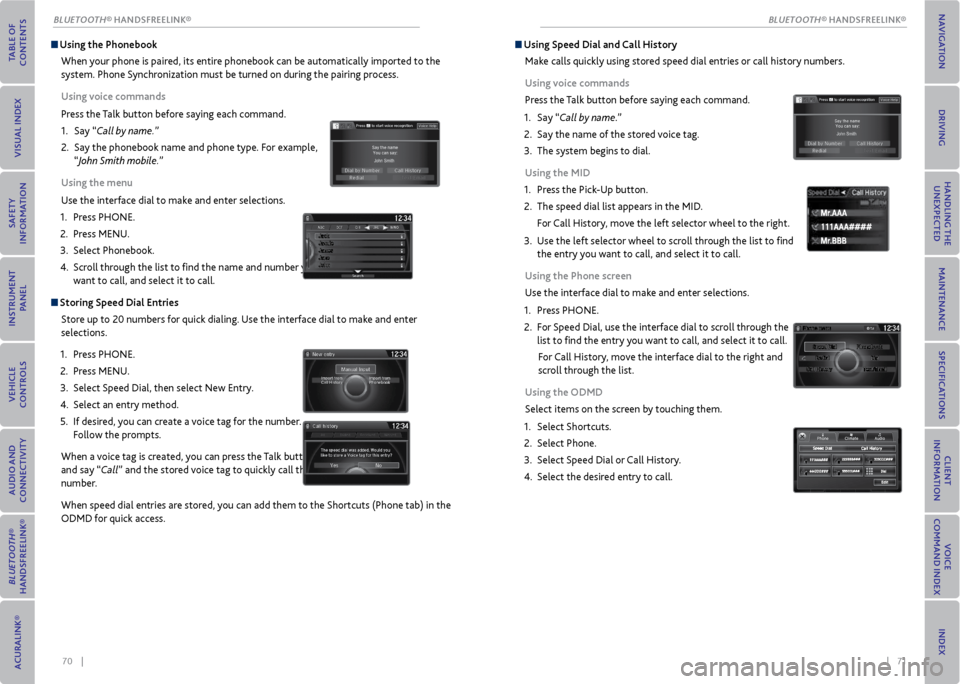
70 || 71
Using the Phonebook
When your phone is paired, its entire phonebook can be automatically imported to the
system. Phone Synchronization must be turned on during the pairing process.
Using voice commands
Press the Talk button before saying each command.
1. Say “Call by name.”
2. Say the phonebook name and phone type. For example,
“John Smith mobile.”
Using the menu
Use the interface dial to make and enter selections.
1. Press PHONE.
2. Press MENU.
3. Select Phonebook.
4. Scroll through the list to find the name and number you
want to call, and select it to call.
Storing Speed Dial entries
Store up to 20 numbers for quick dialing. Use the interface dial to make and enter
selections.
1. Press PHONE.
2. Press MENU.
3. Select Speed Dial, then select New Entry.
4. Select an entry method.
5. If desired, you can create a voice tag for the number.
Follow the prompts.
When a voice tag is created, you can press the Talk button
and say “Call” and the stored voice tag to quickly call the
number.
When speed dial entries are stored, you can add them to the Shortcuts (Phone tab) in the
ODMD for quick access.
Using Speed Dial and Call History
Make calls quickly using stored speed dial entries or call history numbers.
Using voice commands
Press the Talk button before saying each command.
1. Say “Call by name.”
2. Say the name of the stored voice tag.
3. The system begins to dial.
Using the mID
1. Press the Pick-Up button.
2. The speed dial list appears in the MID.
For Call History, move the left selector wheel to the right.
3. Use the left selector wheel to scroll through the list to find
the entry you want to call, and select it to call.
Using the Phone screen
Use the interface dial to make and enter selections.
1. Press PHONE.
2. For Speed Dial, use the interface dial to scroll through the
list to find the entry you want to call, and select it to call.
For Call History, move the interface dial to the right and
scroll through the list.
Using the oDmD
Select items on the screen by touching them.
1. Select Shortcuts.
2. Select Phone.
3. Select Speed Dial or Call History.
4. Select the desired entry to call.
111AAA####
Mr.AAA
Mr.BBB
111AAA####
Mr.AAA
Mr.BBB
BLUeTooTH® HANDSFREELINK®
BLUeTooTH® HANDSFREELINK®
Page 46 of 79
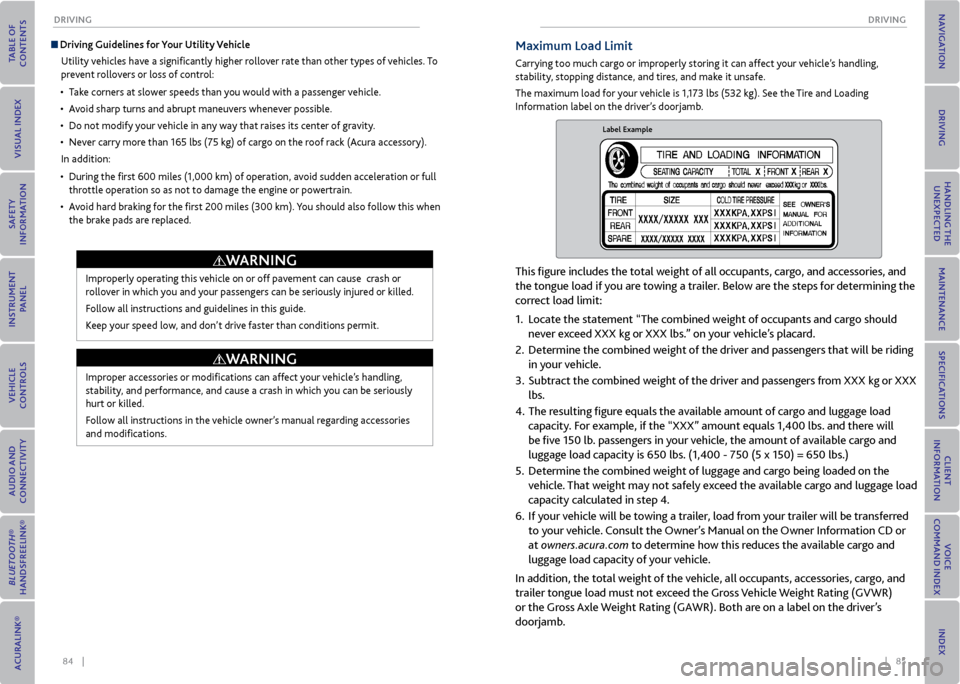
84 || 85
DrIvING
DrIvING
Driving Guidelines for y our Utility v ehicle
Utility vehicles have a significantly higher rollover rate than other types of vehicles. To
prevent rollovers or loss of control:
• Take corners at slower speeds than you would with a passenger vehicle.
• Avoid sharp turns and abrupt maneuvers whenever possible.
• Do not modify your vehicle in any way that raises its center of gravity.
• Never carry more than 165 lbs (75 kg) of cargo on the roof rack (Acura accessory).
In addition:
• During the first 600 miles (1,000 km) of operation, avoid sudden acceleration or full
throttle operation so as not to damage the engine or powertrain.
• Avoid hard braking for the first 200 miles (300 km). You should also follow this when
the brake pads are replaced.
Improperly operating this vehicle on or off pavement can cause crash or
rollover in which you and your passengers can be seriously injured or killed.
Follow all instructions and guidelines in this guide.
Keep your speed low, and don’t drive faster than conditions permit.
WArNING
Improper accessories or modifications can affect your vehicle’s handling,
stability, and performance, and cause a crash in which you can be seriously
hurt or killed.
Follow all instructions in the vehicle owner’s manual regarding accessories
and modifications.
WArNING
maximum Load Limit
Carrying too much cargo or improperly storing it can affect your vehicle’s handling,
stability, stopping distance, and tires, and make it unsafe.
The maximum load for your vehicle is 1,173 lbs (532 kg). See the Tire and Loading
Information label on the driver’s doorjamb.
Label Example
This figure includes the total weight of all occupants, cargo, and accessories, and
the tongue load if you are towing a trailer. Below are the steps for determining the
correct load limit:
1. Locate the statement “The combined weight of occupants and cargo should
never exceed XXX kg or XXX lbs.” on your vehicle’s placard.
2. Determine the combined weight of the driver and passengers that will be riding
in your vehicle.
3. Subtract the combined weight of the driver and passengers from XXX kg or XXX
lbs.
4. The resulting figure equals the available amount of cargo and luggage load
capacity. For example, if the “XXX” amount equals 1,400 lbs. and there will
be five 150 lb. passengers in your vehicle, the amount of available cargo and
luggage load capacity is 650 lbs. (1,400 - 750 (5 x 150) = 650 lbs.)\
5. Determine the combined weight of luggage and cargo being loaded on the
vehicle. That weight may not safely exceed the available cargo and luggage load
capacity calculated in step 4.
6. If your vehicle will be towing a trailer, load from your trailer will be transferred
to your vehicle. Consult the Owner’s Manual on the Owner Information CD or
at owners.acura.com to determine how this reduces the available cargo and
luggage load capacity of your vehicle.
In addition, the total weight of the vehicle, all occupants, accessories, cargo, and
trailer tongue load must not exceed the Gross Vehicle Weight Rating (GVWR)
or the Gross Axle Weight Rating (GAWR). Both are on a label on the driver’s
doorjamb.
Page 51 of 79
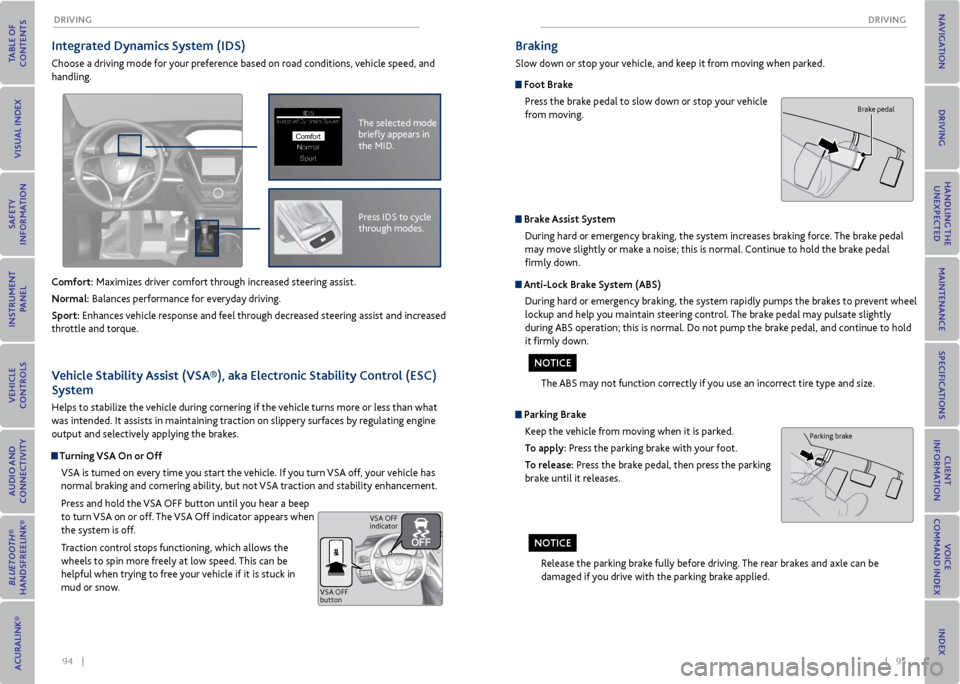
94 || 95
DrIvING
DrIvING
Integrated Dynamics System (IDS)
Choose a driving mode for your preference based on road conditions, vehicle speed, and
handling.
Comfort: Maximizes driver comfort through increased steering assist.
Normal: Balances performance for everyday driving.
Sport: Enhances vehicle response and feel through decreased steering assist and increased
throttle and torque.
The selected mode
briefly appears in
the MID.IDSIntegrated Dynamics System
NormalSport
Comfort
Press IDS to cycle
through modes.
v ehicle Stability Assist (vSA®), aka electronic Stability Control (eSC)
System
Helps to stabilize the vehicle during cornering if the vehicle turns more or less than what
was intended. It assists in maintaining traction on slippery surfaces by regulating engine
output and selectively applying the brakes.
Turning vSA on or off
VSA is turned on every time you start the vehicle. If you turn VSA off, your vehicle has
normal braking and cornering ability, but not VSA traction and stability enhancement.
Press and hold the VSA OFF button until you hear a beep
to turn VSA on or off. The VSA Off indicator appears when
the system is off.
Traction control stops functioning, which allows the
wheels to spin more freely at low speed. This can be
helpful when trying to free your vehicle if it is stuck in
mud or snow.
VSA OFF
button VSA OFF
indicator
Braking
Slow down or stop your vehicle, and keep it from moving when parked.
Foot Brake
Press the brake pedal to slow down or stop your vehicle
from moving.
Parking BrakeKeep the vehicle from moving when it is parked.
To apply: Press the parking brake with your foot.
To release: Press the brake pedal, then press the parking
brake until it releases.
Brake Assist SystemDuring hard or emergency braking, the system increases braking force. The brake pedal
may move slightly or make a noise; this is normal. Continue to hold the brake pedal
firmly down.
Anti-Lock Brake System (ABS)
During hard or emergency braking, the system rapidly pumps the brakes to prevent wheel
lockup and help you maintain steering control. The brake pedal may pulsate slightly
during ABS operation; this is normal. Do not pump the brake pedal, and continue to hold
it firmly down.
The ABS may not function correctly if you use an incorrect tire type and size.
Release the parking brake fully before driving. The rear brakes and axle can be
damaged if you drive with the parking brake applied.
Brake pedal
Parking brake
No TICe
NoTICe
Page 69 of 79
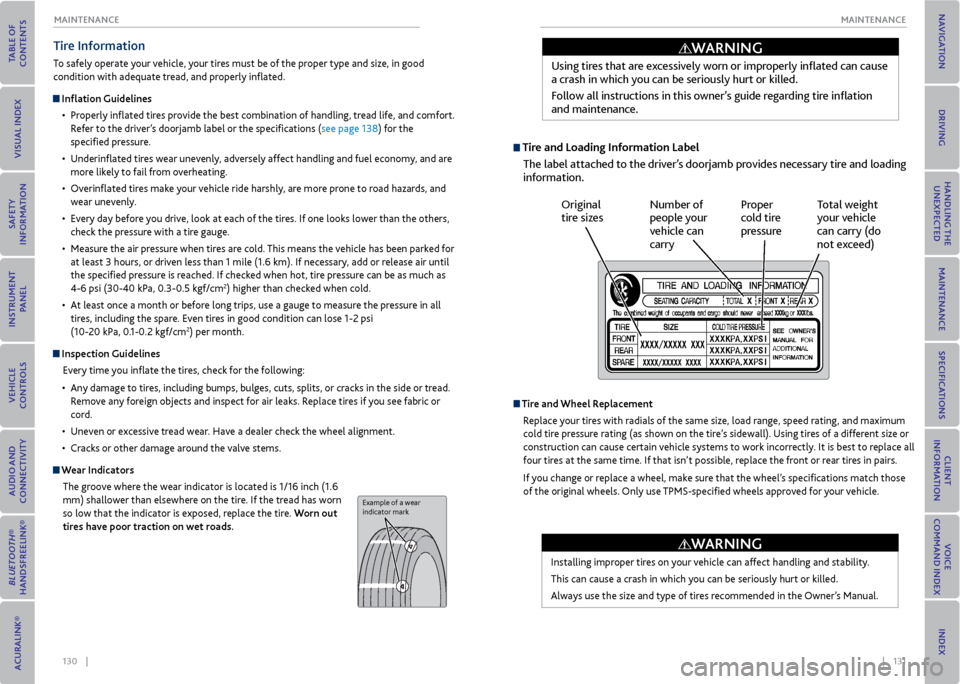
130 || 131
mAINTeNANCe
mAINTeNANCe
Tire Information
To safely operate your vehicle, your tires must be of the proper type and size, in good
condition with adequate tread, and properly inflated.
Inflation Guidelines
• Properly inflated tires provide the best combination of handling, tread life, and comfort.
Refer to the driver’s doorjamb label or the specifications (see page 138) for the
specified pressure.
• Underinflated tires wear unevenly, adversely affect handling and fuel economy, and are
more likely to fail from overheating.
• Overinflated tires make your vehicle ride harshly, are more prone to road hazards, and
wear unevenly.
• Every day before you drive, look at each of the tires. If one looks lower than the others,
check the pressure with a tire gauge.
• Measure the air pressure when tires are cold. This means the vehicle has been parked for
at least 3 hours, or driven less than 1 mile (1.6 km). If necessary, add or release air until
the specified pressure is reached. If checked when hot, tire pressure can be as much as
4-6 psi (30-40 kPa, 0.3-0.5 kgf/cm
2) higher than checked when cold.
• At least once a month or before long trips, use a gauge to measure the pressure in all
tires, including the spare. Even tires in good condition can lose 1-2 psi
(10-20 kPa, 0.1-0.2 kgf/cm
2) per month.
Inspection Guidelines
Every time you inflate the tires, check for the following:
• Any damage to tires, including bumps, bulges, cuts, splits, or cracks in the side or tread.
Remove any foreign objects and inspect for air leaks. Replace tires if you see fabric or
cord.
• Uneven or excessive tread wear. Have a dealer check the wheel alignment.
• Cracks or other damage around the valve stems.
Wear Indicators
The groove where the wear indicator is located is 1/16 inch (1.6
mm) shallower than elsewhere on the tire. If the tread has worn
so low that the indicator is exposed, replace the tire. Worn out
tires have poor traction on wet roads.
Example of a wear
indicator mark
Tire and Loading Information LabelThe label attached to the driver’s doorjamb provides necessary tire and loading
information. Using tires that are excessively worn or improperly inflated can cause
a crash in which you can be seriously hurt or killed.
Follow all instructions in this owner’s guide regarding tire inflation
and maintenance.
Original
tire sizes
Number of
people your
vehicle can
carry Proper
cold tire
pressure
Total weight
your vehicle
can carry (do
not exceed)
Tire and Wheel r eplacement
Replace your tires with radials of the same size, load range, speed rating, and maximum
cold tire pressure rating (as shown on the tire’s sidewall). Using tires of a different size or
construction can cause certain vehicle systems to work incorrectly. It is best to replace all
four tires at the same time. If that isn’t possible, replace the front or rear tires in pairs.
If you change or replace a wheel, make sure that the wheel’s specifications match those
of the original wheels. Only use TPMS-specified wheels approved for your vehicle.
Installing improper tires on your vehicle can affect handling and stability.
This can cause a crash in which you can be seriously hurt or killed.
Always use the size and type of tires recommended in the Owner’s Manual.
WArNING
WArNING
Page 70 of 79
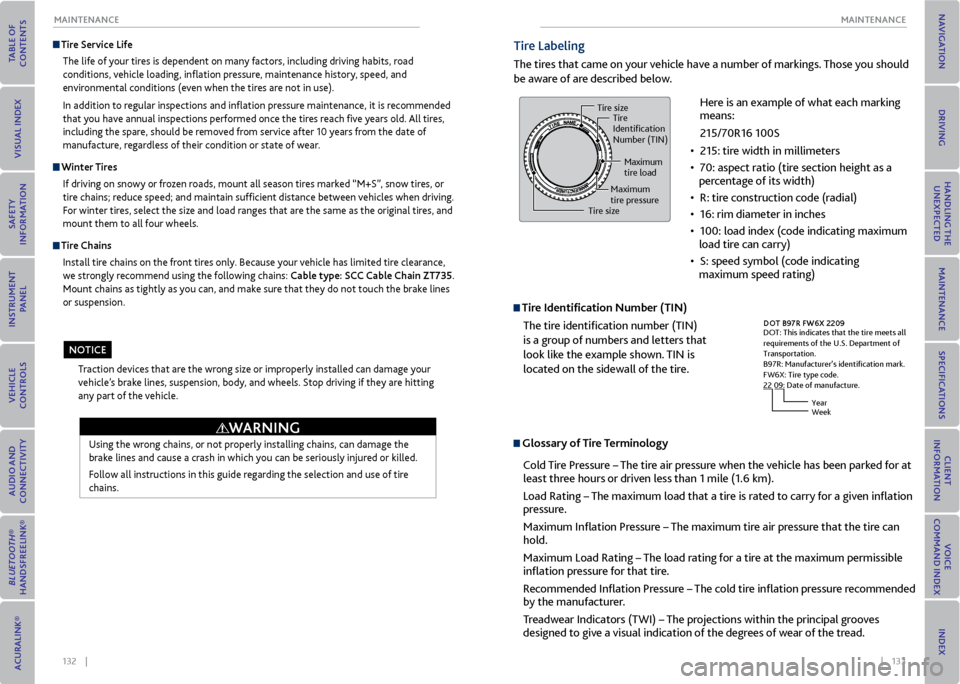
132 || 133
mAINTeNANCe
mAINTeNANCe
Tire Service Life
The life of your tires is dependent on many factors, including driving habits, road
conditions, vehicle loading, inflation pressure, maintenance history, speed, and
environmental conditions (even when the tires are not in use).
In addition to regular inspections and inflation pressure maintenance, it is recommended
that you have annual inspections performed once the tires reach five years old. All tires,
including the spare, should be removed from service after 10 years from the date of
manufacture, regardless of their condition or state of wear.
Winter Tires
If driving on snowy or frozen roads, mount all season tires marked “M+S”, snow tires, or
tire chains; reduce speed; and maintain sufficient distance between vehicles when driving.
For winter tires, select the size and load ranges that are the same as the original tires, and
mount them to all four wheels.
Tire Chains
Install tire chains on the front tires only. Because your vehicle has limited tire clearance,
we strongly recommend using the following chains: Cable type: SCC Cable Chain ZT735.
Mount chains as tightly as you can, and make sure that they do not touch the brake lines
or suspension.
Using the wrong chains, or not properly installing chains, can damage the
brake lines and cause a crash in which you can be seriously injured or killed.
Follow all instructions in this guide regarding the selection and use of tire
chains.
Traction devices that are the wrong size or improperly installed can damage your
vehicle’s brake lines, suspension, body, and wheels. Stop driving if they are hitting
any part of the vehicle.
WArNING
NoTICe
Tire Labeling
The tires that came on your vehicle have a number of markings. Those you should
be aware of are described below.
Tire Identification Number (TIN)
The tire identification number (TIN)
is a group of numbers and letters that
look like the example shown. TIN is
located on the sidewall of the tire.
Glossary of Tire Terminology
Cold Tire Pressure – The tire air pressure when the vehicle has been parked for at
least three hours or driven less than 1 mile (1.6 km).
Load Rating – The maximum load that a tire is rated to carry for a given inflation
pressure.
Maximum Inflation Pressure – The maximum tire air pressure that the tire can
hold.
Maximum Load Rating – The load rating for a tire at the maximum permissible
inflation pressure for that tire.
Recommended Inflation Pressure – The cold tire inflation pressure recommended
by the manufacturer.
Treadwear Indicators (TWI) – The projections within the principal grooves
designed to give a visual indication of the degrees of wear of the tread.
DO T B97R FW6X 2209
DOT: This indicates that the tire meets all
requirements of the
U.S. Department of Transportation.
B97R: Manufacturer’s identi�cation mark.
FW6X: Tire type code.
22 09: Date of manufacture.
YearWeek
Here is an example of what each marking
means:
215/70R16 100S
• 215: tire width in millimeters
• 70: aspect ratio (tire section height as a
percentage of its width)
• R: tire construction code (radial)
• 16: rim diameter in inches
• 100: load index (code indicating maximum
load tire can carry)
• S: speed symbol (code indicating
maximum speed rating)Tire size Tire
Identi�cation
Number (TIN)
Maximum
tire load
Maximum
tire pressure
Tire size
Page 73 of 79
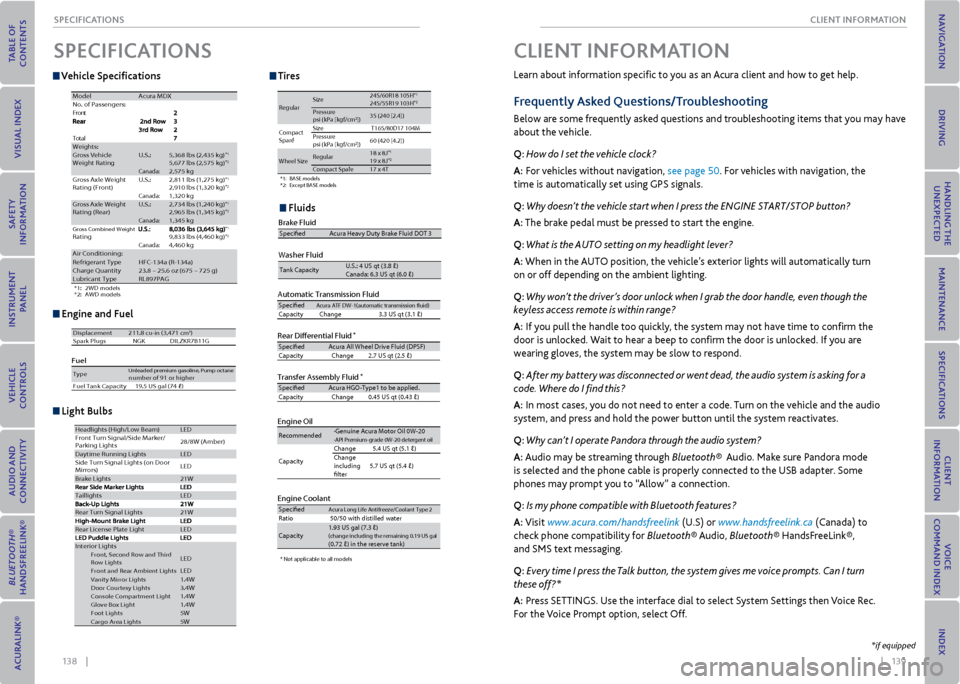
138 || 139
CLIeNT INFormATIoN
SPeCIFICATIoNS
v ehicle Specifications
engine and Fuel
Fluids
*1 :2 WD model s
*2 :A WD model s
ModelAcura MDX
No. of Passengers:
t
n
o
r
F
l
a
t
o
TWeights:Gross Vehicle
Weight Ratin gU.S.:5,368 lbs (2,435 kg)*15,677 lbs (2,575 kg)*2Canada:2,575 kgGross Axle Weight
Rating (Front )U.S.:2,811 lbs (1,275 kg )*12,910 lbs (1,320 kg)*2Canada:1,320 kgGross Axle Weight
Rating (R ear)U.S.:2,734 lbs (1,240 kg )*12,965 lbs (1,345 kg)*2Canada:1,345 kgGross Combined Weight Rating*19,833 lbs (4,460 kg )*2Canada:4,460 kgAir Conditioning :Refrigerant TypeHFC-134a (R-134a )Charge Quantity23.8 – 25.6 oz (675 – 725 g)Lubricant TypeRL897PAG
Engine Specifcatio\hn s
FuelDisplacement211.8 cu-in (3,471 cm3)
Spark Plug sN GKDILZKR7B11 G
TypeUnleaded premium gasoline, Pump octane number of 91 or higher
Fuel Tank Capacity 19.5 US gal (74 �)
Light \fulbsHeadl ights (High/Low Beam )LED
Front Turn Signal/Side Marker /
Parking Lights 28
/8W (A mber)
Daytime Running Light sLED
Si de Turn Si gnal Lights (on Door
Mirrors ) LED
Brake Lights21
W
Taillight sLED
Rear Turn Signal Li ghts21W
Rear License Plate Ligh tLED
Interior LightsFront, Second Row and Third
Ro w LightsLED
Front and Rear Ambient LightsLEDVa nity Mirror Lights 1.4WDoor Courtesy Lights3.4WConsole Compartment Ligh t1.4WGlove Box Ligh t1.4WFoot Lights5WCargo Area Lights5WAutomatic Transmis\Dsion Fluid
Rear Di\ferential Fl\Duid*
Transfer Assembl\b Fl\Duid*
Specife dAcura ATF DW-1(au\fo\(ma\fic \fran\bmi\b\bion fuid\( )Capaci\fy Change 3.3 US q \f (3.1 �)
Specife dAcura All Wheel Dr\(ive Fluid (DPSF )
Ca paci\fy Change2.7 US q\f (2.5 �)
Specife dAcura HGO-Type1 \fo \(be appli ed.
Ca paci\fy Change0.45 US q\f (0.43 �)
Engine Oil
Engine Coolant
Recommended·Genuine Acura Mo\for\( Oil 0W-20·API Premium-grade \(0W-20 de\fe rgen\f oil
Capaci\fy Change
5.4 US q\f (5.1 �)
Change
including
fl\fer 5.7 US q\f (5.4 �)
SpecifedAcura Long L
ife An\fifreeze/Cool\(an\f Type 2Ra\fio50/50 wi\fh di\b\filled\( wa\fer
Capaci\fy1.93 US g al (7.3 �)(change including \fhe\( remaining 0.19 US ga\(l (0.72 �) in \fhe re\ber\(ve \fank)
Tire
*1:B ASE model\b
*2 :E xcep\f BASE model \b
Regula r Size
245/60R18 105H
*1245/55R19 103H*2Pre\b\bure
p\b i (kPa [kgf/c m2])35 (24
0 [2.4])
Compac\f
Spar e
*Size T165/80D17 104M
Pre\b\bure
p\b i (kPa [kgf/cm
2]) 60 (42
0 [4.2])
Wheel Size Regular
18 x 8J*119 x 8J*2Compac\f Spare*17 x 4T
* Not applicable to all models
Washer Fluid
Tank Capaci\fyU.S.: 4 US q\f (3.8 �)
Ca nada: 6.3 US q\f (6.0 \(�)
Brake FluidSpecifedAcura Heavy Du\fy Br\(ake Fluid DOT 3
SPeCIFICATIoNS
*1:2 WD model s
*2 :A WD model s
ModelAcura MDX
No. of Passengers:
t
n
o
r
F
l
a
t
o
TWeights:Gross Vehicle
Weight Ratin gU.S.:5,368 lbs (2,435 kg)*15,677 lbs (2,575 kg)*2Canada:2,575 kgGross Axle Weight
Rating (Front )U.S.:2,811 lbs (1,275 kg )*12,910 lbs (1,320 kg)*2Canada:1,320 kgGross Axle Weight
Rating (R ear)U.S.:2,734 lbs (1,240 kg )*12,965 lbs (1,345 kg)*2Canada:1,345 kgGross Combined Weight Rating*19,833 lbs (4,460 kg )*2Canada:4,460 kgAir Conditioning :Refrigerant TypeHFC-134a (R-134a )Charge Quantity23.8 – 25.6 oz (675 – 725 g)Lubricant TypeRL897PAG
Engine Specifcatio\hn s
FuelDisplacement211.8 cu-in (3,471 cm3)
Spark Plug sN GKDILZKR7B11 G
TypeUnleaded premium gasoline, Pump octane number of 91 or higher
Fuel Tank Capacity 19.5 US gal (74 �)
Light \fulbsHeadl ights (High/Low Beam )LED
Front Turn Signal/Side Marker /
Parking Lights 28
/8W (A mber)
Daytime Running Light sLED
Si de Turn Si gnal Lights (on Door
Mirrors ) LED
Brake Lights21
W
Taillight sLED
Rear Turn Signal Li ghts21W
Rear License Plate Ligh tLED
Interior LightsFront, Second Row and Third
Ro w LightsLEDFront and Rear Ambient LightsLEDVa nity Mirror Lights 1.4WDoor Courtesy Lights3.4WConsole Compartment Ligh t1.4WGlove Box Ligh t1.4WFoot Lights5WCargo Area Lights5W
TiresAutomatic Transmis\Dsion Flui d
Rear Di\ferential Fl\Dui d
*
Transfer Assembl\b Fl\Duid*
SpecifedAcura ATF DW-1(au\fo\(ma\fic \fran\bmi\b\bion fuid\( )Capaci\fy Change 3.3 US q \f (3.1 �)
Specife d Acura All Wheel Dr\(ive Fluid (DPSF )
Ca paci\fy Change2.7 US q\f (2.5 �)
Specife d Acura HGO-Type1 \fo \(be appli ed.
Ca paci\fy Change0.45 US q\f (0.43 �)
Engine Oi l
Engine Coolan t
Recommended ·Genuine Acura Mo\for\( Oil 0W-20·API Premium-grade \(0W-20 de\fe
rgen\f oil
Capaci\fy Change
5.4 US q\f (5.1 �)
Change
including
fl\fer 5.7 US q\f (5.4 �)
Specifed
Acura Long L ife An\fifreeze/Cool\(an\f Type 2Ra\fio50/50 wi\fh di\b\filled\( wa\fer
Capaci\fy 1.93
US g al (7.3 �)
(change including \fhe\( remaining 0.19 US ga\(l (0.72 �) in \fhe re\ber\(ve \fank)
Tire
*1:B ASE model\b
*2 :E xcep\f BASE model \b
Regula rSize245/60R18 105H*1245/55R19 103H*2Pre\b\bure
p\b i (kPa [kgf/c m2])35 (240 [2.4])
Compac\f
Spar e
*Size T165/80D17 104M
Pre\b\bure
p\b i (kPa [kgf/cm
2]) 60 (42
0 [4.2])
Wheel SizeRegular18 x 8J*119 x 8J*2Compac\f Spare*17 x 4T
* Not applicable to all models
Washer Fluid
Tank Capaci\fy U.S.: 4 US q\f (3.8 �)
Ca nada: 6.3 US q\f (6.0 \(�)
Brake FluidSpecifed Acura Heavy Du\fy Br\(ake Fluid DOT 3
Light Bulbs
*1:2 WD model s
*2 :A WD model s
ModelAcura MDX
No. of Passengers:
t
n
o
r
F
l
a
t
o
TWeights:Gross Vehicle
Weight Ratin gU.S.:5,368 lbs (2,435 kg)*15,677 lbs (2,575 kg)*2Canada:2,575 kgGross Axle Weight
Rating (Front )U.S.:2,811 lbs (1,275 kg )*12,910 lbs (1,320 kg)*2Canada:1,320 kgGross Axle Weight
Rating (R ear)U.S.:2,734 lbs (1,240 kg )*12,965 lbs (1,345 kg)*2Canada:1,345 kgGross Combined Weight Rating*19,833 lbs (4,460 kg )*2Canada:4,460 kgAir Conditioning :Refrigerant TypeHFC-134a (R-134a )Charge Quantity23.8 – 25.6 oz (675 – 725 g)Lubricant TypeRL897PAG
Engine Specifcatio\hn s
FuelDisplacement211.8 cu-in (3,471 cm3)
Spark Plug sN GKDILZKR7B11 G
TypeUnleaded premium gasoline, Pump octane number of 91 or higher
Fuel Tank Capacity 19.5 US gal (74 �)
Light \fulbsHeadl ights (High/Low Beam )LED
Front Turn Signal/Side Marker /
Parking Lights 28
/8W (A mber)
Daytime Running Light sLED
Si de Turn Si gnal Lights (on Door
Mirrors ) LED
Brake Lights21
W
Taillight sLED
Rear Turn Signal Li ghts21W
Rear License Plate Ligh tLED
Interior LightsFront, Second Row and Third
Ro w LightsLED
Front and Rear Ambient LightsLEDVa nity Mirror Lights 1.4WDoor Courtesy Lights3.4WConsole Compartment Ligh t1.4WGlove Box Ligh t1.4WFoot Lights5WCargo Area Lights5W
Learn about information specific to you as an Acura client and how to get help.
Frequently Asked Questions/Troubleshooting
Below are some frequently asked questions and troubleshooting items that you may have
about the vehicle.
Q: How do I set the vehicle clock?
A: For vehicles without navigation, see page 50. For vehicles with navigation, the
time is automatically set using GPS signals.
Q: Why doesn’t the vehicle start when I press the ENGINE START/STOP button?
A: The brake pedal must be pressed to start the engine.
Q: What is the AUTO setting on my headlight lever?
A: When in the AUTO position, the vehicle’s exterior lights will automatically turn
on or off depending on the ambient lighting.
Q: Why won’t the driver’s door unlock when I grab the door handle, even though the
keyless access remote is within range?
A: If you pull the handle too quickly, the system may not have time to confirm the
door is unlocked. Wait to hear a beep to confirm the door is unlocked. If you are
wearing gloves, the system may be slow to respond.
Q: After my battery was disconnected or went dead, the audio system is asking for a
code. Where do I find this?
A: In most cases, you do not need to enter a code. Turn on the vehicle and the audio
system, and press and hold the power button until the system reactivates.
Q: Why can’t I operate Pandora through the audio system?
A: Audio may be streaming through Bluetooth® Audio. Make sure Pandora mode
is selected and the phone cable is properly connected to the USB adapter. Some
phones may prompt you to “Allow” a connection.
Q: Is my phone compatible with Bluetooth features?
A: Visit www.acura.com/handsfreelink (U.S) or www.handsfreelink.ca (Canada) to
check phone compatibility for Bluetooth® Audio, Bluetooth® HandsFreeLink®,
and SMS text messaging.
Q: Every time I press the Talk button, the system gives me voice prompts. Can I turn
these off?*
A: Press SETTINGS. Use the interface dial to select System Settings then Voice Rec.
For the Voice Prompt option, select Off.
CLIeNT INFormATIoN
*if equipped
Page 75 of 79
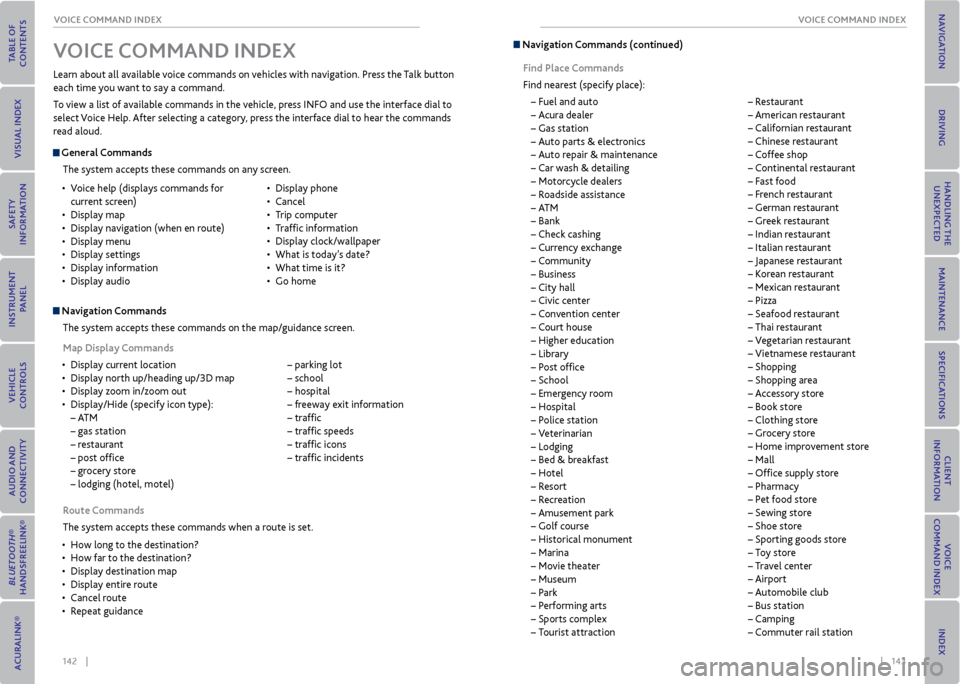
142 || 143
voICe CommAND INDex
voICe CommAND INDex
General Commands
The system accepts these commands on any screen.
Navigation CommandsThe system accepts these commands on the map/guidance screen.
map Display Commands
• Display current location
• Display north up/heading up/3D map
• Display zoom in/zoom out
• Display/Hide (specify icon type):
– AT M
– gas station
– restaurant
– post office
– grocery store
– lodging (hotel, motel)
– parking lot
– school
– hospital
– freeway exit information
– traffic
– traffic speeds
– traffic icons
– traffic incidents
Learn about all available voice commands on vehicles with navigation. Press the Talk button
each time you want to say a command.
To view a list of available commands in the vehicle, press INFO and use the interface dial to
select Voice Help. After selecting a category, press the interface dial to hear the commands
read aloud.
v
oICe CommAND INDex
• Voice help (displays commands for
current screen)
• Display map
• Display navigation (when en route)
• Display menu
• Display settings
• Display information
• Display audio •
Display phone
• Cancel
• Trip computer
• Traffic information
• Display clock/wallpaper
• What is today’s date?
• What time is it?
• Go home
r oute Commands
The system accepts these commands when a route is set.
• How long to the destination?
• How far to the destination?
• Display destination map
• Display entire route
• Cancel route
• Repeat guidance
Navigation Commands (continued)
Find Place Commands
Find nearest (specify place):
– Fuel and auto
– Acura dealer
– Gas station
– Auto parts & electronics
– Auto repair & maintenance
– Car wash & detailing
– Motorcycle dealers
– Roadside assistance
– AT M
– Bank
– Check cashing
– Currency exchange
– Community
– Business
– City hall
– Civic center
– Convention center
– Court house
– Higher education
– Library
– Post office
– School
– Emergency room
– Hospital
– Police station
– Veterinarian
– Lodging
– Bed & breakfast
– Hotel
– Resort
– Recreation
– Amusement park
– Golf course
– Historical monument
– Marina
– Movie theater
– Museum
– Park
– Performing arts
– Sports complex
– Tourist attraction
– Restaurant
– American restaurant
– Californian restaurant
– Chinese restaurant
– Coffee shop
– Continental restaurant
– Fast food
– French restaurant
– German restaurant
– Greek restaurant
– Indian restaurant
– Italian restaurant
– Japanese restaurant
– Korean restaurant
– Mexican restaurant
– Pizza
– Seafood restaurant
– Thai restaurant
– Vegetarian restaurant
– Vietnamese restaurant
– Shopping
– Shopping area
– Accessory store
– Book store
– Clothing store
– Grocery store
– Home improvement store
– Mall
– Office supply store
– Pharmacy
– Pet food store
– Sewing store
– Shoe store
– Sporting goods store
– Toy store
– Travel center
– Airport
– Automobile club
– Bus station
– Camping
– Commuter rail station